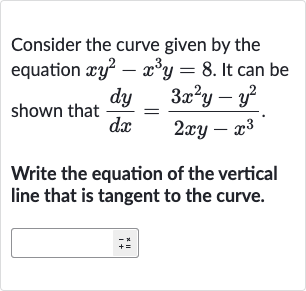Full solution
Q. Consider the curve given by the equation . It can be shown that .Write the equation of the vertical line that is tangent to the curve.
- Set Denominator Equal to Zero: To find the vertical tangent, we need to set the denominator of the derivative equal to zero, because the slope of a vertical line is undefined, and this occurs when the denominator of the slope expression is zero.
- Factor and Solve for : The denominator of the derivative is . Set this equal to zero to find the -values where the tangent line could be vertical.
- Check : Factor out from the equation.
- Solve for : Setting each factor equal to zero gives us the -values where the tangent could be vertical. or
- Substitute into Original Equation: If , then the equation is automatically satisfied, so we don't get additional information from the second factor. We need to check if is indeed a point on the curve.
- Simplify and Combine Terms: Substitute into the original equation to see if it yields a valid point on the curve.This is not true, so is not a point on the curve, and therefore cannot be where a vertical tangent occurs.
- Solve for : Now, let's solve the second factor for to find the corresponding -values for the vertical tangent.
- No Real Solution: Substitute back into the original equation to find the -values that satisfy both the original equation and the condition for a vertical tangent.
- No Real Solution: Substitute back into the original equation to find the -values that satisfy both the original equation and the condition for a vertical tangent. Simplify the equation.
- No Real Solution: Substitute back into the original equation to find the -values that satisfy both the original equation and the condition for a vertical tangent. Simplify the equation. Combine like terms.
- No Real Solution: Substitute back into the original equation to find the -values that satisfy both the original equation and the condition for a vertical tangent. Simplify the equation. Combine like terms. Multiply both sides by to solve for .
- No Real Solution: Substitute back into the original equation to find the -values that satisfy both the original equation and the condition for a vertical tangent.Simplify the equation.Combine like terms.Multiply both sides by to solve for .Since has no real solution (as the fifth root of a negative number is not real), there are no -values that satisfy the condition for a vertical tangent on the curve . Therefore, there is no vertical line that is tangent to the curve.

